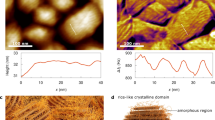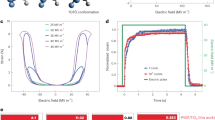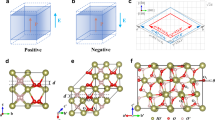Abstract
Piezoelectricity describes interconversion between electrical charge and mechanical strain. As expected for lattice ions displaced in an electric field, the proportionality constant is positive for all piezoelectric materials. The exceptions are poly(vinylidene fluoride) (PVDF) and its copolymers with trifluoroethylene (P(VDF-TrFE)), which exhibit a negative longitudinal piezoelectric coefficient. Reported explanations exclusively consider contraction with applied electric field of either the crystalline or the amorphous part of these semi-crystalline polymers. To distinguish between these conflicting interpretations, we have performed in situ dynamic X-ray diffraction measurements on P(VDF-TrFE) capacitors. We find that the piezoelectric effect is dominated by the change in lattice constant but, surprisingly, it cannot be accounted for by the polarization-biased electrostrictive contribution of the crystalline part alone. Our quantitative analysis shows that an additional contribution is operative, which we argue is due to an electromechanical coupling between the intermixed crystalline lamellae and amorphous regions. Our findings tie the counterintuitive negative piezoelectric response of PVDF and its copolymers to the dynamics of their composite microstructure.
This is a preview of subscription content, access via your institution
Access options
Subscribe to this journal
Receive 12 print issues and online access
$259.00 per year
only $21.58 per issue
Buy this article
- Purchase on Springer Link
- Instant access to full article PDF
Prices may be subject to local taxes which are calculated during checkout




Similar content being viewed by others
References
Furukawa, T. & Seo, N. Electrostriction as the origin of piezoelectricity in ferroelectric polymers. Jpn. J. Appl. Phys. 29, 675–680 (1990).
Bystrov, V. S. et al. Molecular modeling of the piezoelectric effect in the ferroelectric polymer poly(vinylidene fluoride) (PVDF). J. Mol. Model. 19, 3591–3602 (2013).
Wada, Y. & Hayakawa, R. A model theory of piezo- and pyroelectricity of poly(vinylidene fluoride) electret. Ferroelectrics 32, 115–118 (1981).
Furukawa, T., When, J. X., Suzuki, K., Takashina, Y. & Date, M. Piezoelectricity and pyroelectricity in vinylidene fluoride/trifluoroehtylene copolymers. J. Appl. Phys. 56, 829–834 (1984).
Broadhurst, M. G. & Davis, G. T. Physical basis for piezoelectricity in PVDF. Ferroelectrics 60, 3–13 (1984).
Ejdrup, T. et al. Picosecond time-resolved laser pump/X-ray probe experiments using a gated single-photon-counting area detector. J. Synchrotron Radiat. 16, 387–390 (2009).
Haldrup, K. et al. Guest–host interactions investigated by time-resolved X-ray spectroscopies and scattering at MHz rates: Solvation dynamics and photoinduced spin transition in aqueous Fe(bipy)32+. J. Phys. Chem. A 116, 9878–9887 (2012).
Wurfel, P. & Batra, I. P. Depolarization-field-induced instability in thin ferroelectric films—experiment and theory. Phys. Rev. B 8, 5126–5133 (1973).
Lines, M. E. & Glass, A. M. Principles and Applications of Ferroelectrics and Related Materials (Oxford Univ. Press, 1977).
Stengel, M., Spaldin, N. A. & Vanderbilt, D. Electric displacement as the fundamental variable in electronic-structure calculations. Nature Phys. 5, 304–308 (2009).
Devonshire, A. F. Theory of barium titanate—Part II. Philos. Mag. 42, 1065–1079 (1951).
Newnham, R. E., Sundar, V., Yimnirun, R., Su, J. & Zhang, Q. M. Electrostriction: Nonlinear electromechanical coupling in solid dielectrics. J. Phys. Chem. B 101, 10141–10150 (1997).
Li, F., Jin, L., Xu, Z. & Zhang, S. Electrostrictive effect in ferroelectrics: An alternative approach to improve piezoelectricity. Appl. Phys. Rev. 1, 11103–11121 (2014).
Pramanick, A., Damjanovic, D., Daniels, J. E., Nino, J. C. & Jones, J. L. Origins of electro-mechanical coupling in polycrystalline ferroelectrics during subcoercive electrical loading. J. Am. Ceram. Soc. 94, 293–309 (2011).
Miller, S. L. & McWhorter, P. J. Physics of the ferroelectric nonvolatile memory field effect transistor. J. Appl. Phys. 72, 5999–6010 (1992).
Lue, H.-T., Wu, C.-J. & Tseng, T.-Y. Device modeling of ferroelectric memory field-effect transistor (FeMFET). IEEE Trans. Electron Dev. 49, 1790–1798 (2002).
Brondijk, J. J., Asadi, K., Blom, P. W. M. & de Leeuw, D. M. Physics of organic ferroelectric field-effect transistors. J. Polym. Sci. B 50, 47–54 (2012).
Kepler, R. G. Ferroelectric Polymers Ch. 3 (Marcel Dekker, 1995).
Tagantsev, A. K., Cross, L. E. & Fousek, J. Domains in Ferroic Crystals and Thin Films (Springer, 2010).
Cross, L. E. Ferroelectric Ceramics: Tailoring Properties for Specific Applications (Birkhäuser, 1993).
Lindner, M. et al. Charged cellular polymers with ferroelectric behaviour. IEEE Trans. Dielectr. Electr. Insul. 11, 255–263 (2004).
Rollik, D., Bauer, S. & Gerhard-Multhaupt, R. Separate contributions to the pyroelectricity in polyvinylidene fluoride from the amorphous and crystalline phases, as well as from their interface. J. Appl. Phys. 85, 3282–3288 (1999).
Ueda, H., Fukada, E. & Karasz, F. E. Piezoelectricity in three-phase systems: Effect of the boundary phase. J. Appl. Phys. 60, 2672–2677 (1986).
Turik, A. V. & Radchenko, G. S. Maxwell–Wagner relaxation in piezoactive media. J. Phys. D: Appl. Phys. 35, 1188–1192 (2002).
Acknowledgements
We gratefully acknowledge P. Groen from the Holst Centre, TNO, The Netherlands, for stimulating discussions on inorganic piezoelectrics and ferroelectrics. We are indebted to H. Wondergem, Philips Research, Eindhoven, The Netherlands for X-ray analysis of P(VDF-TrFE) films and to G. Glasser from the Max Plank Institute for Polymer Research, Mainz, Germany, for the SEM micrographs. We acknowledge H. Lemke, currently at the SLAC National Accelerator Laboratory, for his contributions, the beamline scientists A. Beerlink and O. Seeck, as well as the excellent technical support received at P08 at PETRA III, Hamburg. We acknowledge financial support from the Zernike Institute for Advanced Materials, by KAU from project 71-100-35-HiCi, by the EC under FP7 contract no. 212311, ONE-P and by the Max Planck Institute for Polymer Research. K.S.K., T.B.v.D., Y.G. and M.M.N. acknowledge support from DANSCATT. T.B.v.D. and M.M.N. acknowledge support from the ReLiable project (Project No. 11-116792) funded by the Danish Council for Strategic Research Programme Commission on Sustainable Energy and Environment. K.A. acknowledges the Alexander von Humboldt Foundation for the funding provided in the framework of the Sofja Kovalevskaja Award endowed by the Federal Ministry of Education and Research, Germany. D.D. acknowledges support from the Swiss National Science Foundation (No. 200021-159603).
Author information
Authors and Affiliations
Contributions
D.M.d.L. and M.M.N. conceived the idea and designed the experiments. M.L., K.A., D.Z., T.L. and I.K. fabricated and characterized the ferroelectric capacitors. T.B.v.D., K.S.K. and Y.G. performed the synchrotron measurements. I.K. modelled the data. D.D. supervised the theoretical analysis. I.K., K.A., M.L., T.B.v.D., K.S.K., Y.G., P.W.M.B., D.D., M.M.N. and D.M.d.L. co-wrote and commented on the manuscript. I.K. and D.M.d.L. supervised the project.
Corresponding author
Ethics declarations
Competing interests
The authors declare no competing financial interests.
Supplementary information
Supplementary Information
Supplementary Information (PDF 2408 kb)
Rights and permissions
About this article
Cite this article
Katsouras, I., Asadi, K., Li, M. et al. The negative piezoelectric effect of the ferroelectric polymer poly(vinylidene fluoride). Nature Mater 15, 78–84 (2016). https://doi.org/10.1038/nmat4423
Received:
Accepted:
Published:
Issue Date:
DOI: https://doi.org/10.1038/nmat4423
This article is cited by
-
Tunable and parabolic piezoelectricity in hafnia under epitaxial strain
Nature Communications (2024)
-
Auxetic piezoelectric effect in heterostructures
Nature Materials (2024)
-
Recent advances in memristors based on two-dimensional ferroelectric materials
Frontiers of Physics (2024)
-
Towards two-dimensional van der Waals ferroelectrics
Nature Materials (2023)
-
Typical dampers and energy harvesters based on characteristics of ferrofluids
Friction (2023)



